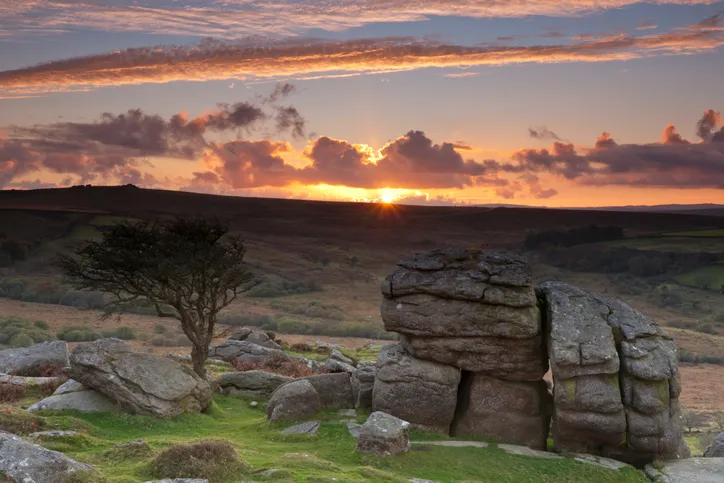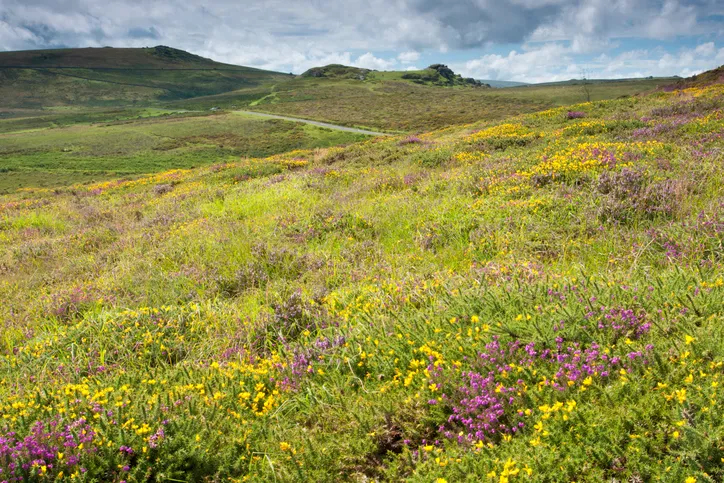This moderate walking route takes in a host of Dartmoor's famous tors – Saddle, Haytor, Howell Tor and Hound Tor.

1. Saddle Tor
Walk from the car park up to Saddle Tor, the favourite haunt of a phantom pony. On quiet nights you can apparently hear its thunderous hoofbeats as it gallops towards you. To your right, follow a clear path leading to Haytor Rocks.
The most famous story attached to Haytor Rocks concerns a young woman who was so desperate to escape an arranged marriage to an old squire that she announced she would only be “the bride of death,” and leapt from the top. Her body was never found, because her dress had billowed out, allowing her to float to the ground and elope with her true love.

2. Haytor Rocks
With the main body of Haytor rocks on your right, go down the hill to Haytor Quarries. Join the disused tramway and follow it to a lake on your right, taking a right on to a path leading up to Smallacombe Rocks. Follow the main line (don’t take the right bend) until the tracks run out. Keep going, joining a bridleway that will take you through Becka Brook Valley, and over a small bridge that fords Becka Brook. This brook was once a site of much fear and dread, for a dragon made its lair here and lived on the moorsmen’s sheep and cows.

3. Hound Tor
You can now see Hound Tor up ahead. Follow the path until you reach the summit, passing the remains of the medieval village of Hundatora, which was only deserted around 1350AD, possibly due to a change in the weather conditions, or more likely due to a bubonic plague outbreak.
Hound Tor is one of the most famous attractions on Dartmoor. The story goes that it was created when a mighty hunter called Bowerman interrupted a coven of witches with his pack of hounds. The witches responded by turning the hunter and his hounds to stone. A mile away, in the direction of Manaton village, you can still see an rock outcrop known as Bowerman’s Nose. Hound Tor is reportedly the site that inspired Arthur Conan Doyle to write The Hound of the Baskervilles.
Related articles
From here, it’s a short walk to Jay’s Grave, which lies in a narrow lane just below the tor. Kitty Jay was a late 18th century suicide, buried at a crossroads since the three local parishes refused to let her lie in consecrated ground. Although the body has since been moved, the site has become something of a shrine – locals claim the flowers on the grave are left by pixies, while passing motorists often report seeing a dark hooded figure kneeling there.
4. Greator Rocks
Between the two towers of Hound Tor, facing the car park below, you can turn left and see Haytor Rocks in the distance. Follow the path heading in this direction. You’ll pass Greator Rocks on your left, and a sign that says “Haytor Down”. After crossing Becka Brook again, go up the slope and take the path to your right. Bear left and go through the gate in the wall. Follow the path back to the car park.
Map
Hound Tor walking route and map.

Useful Information
TERRAIN
Steep moorland paths
HOW TO GET THERE
By car: Take the A382 towards Bovey Tracey, then join the B3387 towards Widecombe.
Public transport: Buses are scarce on Dartmoor, but there’s a summer-only bus service that crosses the moor.
REFRESHMENTS
Widecombe-in-the-Moor, Newton Abbot TQ13 7TF
Tel: 01364 621327
